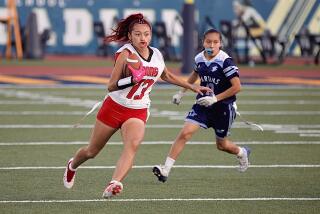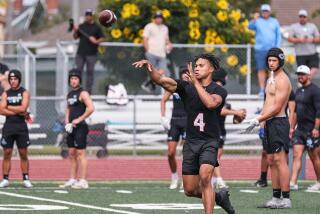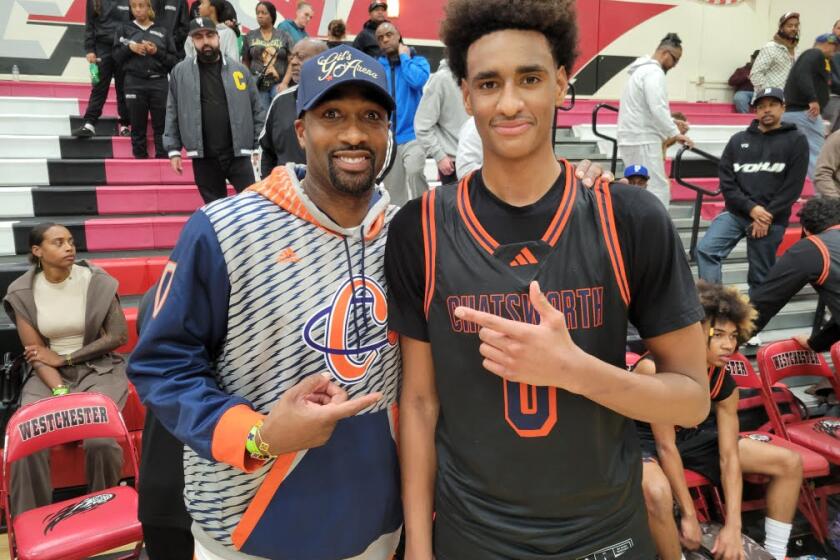A Two-Step Quandary : Declining Enrollment Causes Coaches to Press Players Into Double Duty
Another lengthy, frustrating football practice inched toward conclusion and Skip Giancanelli’s breaking point had long since passed. After 29 years of coaching, it had come to this for the El Camino Real High coach.
A scrawny teen-ager in full but ill-fitting gear, panting heavily from the afternoon’s workout, was as confused now as he was at the start of practice--and the start of the season for that matter. Elementary football techniques baffled the player, whose confusion heightened Giancanelli’s frustration.
“When you have a kid come up and ask you when is he supposed to pass block, you scratch your head,” Giancanelli said.
An assistant rushed in to scold the player for his ignorance, but Giancanelli shooed him away. “When these kids make mistakes I don’t say anything anymore, because they make so many,” he said sadly.
Mistake-prone practices and confused players weren’t always the rule at El Camino Real. In 1970, Giancanelli’s second season, ECR won the West Valley League championship with a 9-0 record and, by the decade’s end, the Conquistadores were a Valley power. Three times in four years only Banning stood between Giancanelli’s teams and a City Section 4-A title. They lost to the Pilots twice in the championship game and once in the semifinals, and are the last Valley team to reach the City 4-A final.
But El Camino Real hardly wins anymore. Last week’s 13-13 tie with Kennedy rates as the program’s high-water mark in the past three seasons. The Conquistadores (0-4-1) have gone 18 games, stretching back to the ’85 season, without a victory on the field.
Giancanelli has only to look around the Woodland Hills neighborhood to find reasons for his program’s decline. The building boom that spawned the school’s inception in 1969 is over, and few new families have arrived. The children who helped swell the school’s enrollment past the 3,000 mark in the ‘70s are grown and have moved away.
El Camino Real, although one of the worst hit, is not alone among West Valley City schools that have declining enrollments. Fewer students means fewer players, a phenomenon that has become a fact of life for many City coaches.
“We just don’t have the kids anymore,” Giancanelli said. “The numbers have been going down, down, down the past five years and it’s getting worse.”
Smaller rosters have forced more and more players to play both offense and defense at Valley high schools.
El Camino Real’s Paul Hasson, a 6-1, 220-pound senior, almost never leaves the field during games. He is the placekicker, the starting fullback, a starting linebacker and the symbol of the new age City player in the Valley: He plays both ways.
Shifting demographics usually are of small consequence to football coaches, but smaller rosters grab their attention. Veteran coaches claim they never had problems finding 22 starters back when 100 players turned out for the team. With rosters more than 100% smaller in some cases, more and more players are pulling double duty, causing more and more coaches to pull out their hair.
“I’d love to have 22 starters but that just isn’t possible anymore,” said Darryl Stroh, who has been a coach at Granada Hills since 1964. “When I was the defensive coordinator here, there were players on offense that I wanted to have, but you were always able to find kids who could do a workmanlike job. No more.
“Last year we had seven kids going both ways. This year is exceptional because we only have two. We’re just lucky this year.”
Myron Gibford, Chatsworth’s coach for nine years, is surprised to see any Granada Hills players pulling double duty.
“They never used to have guys going both ways,” he said. “But it’s an uphill battle all the time just to get kids out. We used to cut our roster down to 60. Now we’ll take anybody. There are kids on our team now that would not have made our ballclub in ’79.”
Joel Schaeffer has coached at Reseda for 17 years, 10 as the head coach. Rosters ran to 70 and 80 for the varsity and junior varsity 10 years ago. This season he has 44 on the varsity with no JV team. Six starters play offense and defense.
“In the ‘70s, I had ‘B’ teams with more than 100 players, but now we have less than 50,” he said. “Last year I had my smallest team ever with 42 on the varsity.”
El Camino Real’s story reflects the trend among City schools west of the San Diego Freeway. Despite overcrowded conditions in other parts of Los Angeles, West Valley schools have headed in the opposite direction since the boom years of the ‘70s.
Schools such as Taft, Canoga Park and Monroe are down 200 to 500 students from 10 years ago. Granada Hills, the district’s largest high school in ’71 with 4,731 students, still had an enrollment of 3,345 in ’77 even though Kennedy was opened nearby five years earlier to accommodate the student crunch. Last year, enrollment at Granada Hills dropped to 2,476.
Ten years ago, ECR’s enrollment was 3,290. Five years later, it dropped almost 1,000 students. Enrollment rose to 2,913 last year, but the numbers are deceiving. ECR added the ninth grade in the fall of ’84.
Hughes Junior High, an El Camino Real feeder school, virtually ran out of students in 1983 and closed its doors that June. It still sits empty on Burbank Avenue.
Giancanelli, the ECR coach since the school opened, remembers 75-player varsity rosters. This year, he takes the field with 37 players behind him and he’s not sure about all of those.
In order to keep the roster size respectable, Giancanelli has changed policies. Before last season, seniors who hadn’t played in the program were not allowed to try out for the team. Giancanelli no longer can afford that dictum.
“We have guys on the varsity who don’t belong there. They don’t have the ability. We have about six or seven seniors who never played football before, and we have second-string guys who don’t know the game,” he said.
Inexperienced players are bad enough in practice, but on game day the problem is magnified.
“They’ve never been in that atmosphere before and with the pressure, everything just blows up in their mind. They get all excited and become totally lost. It gets demoralizing for the good athletes,” he said.
Said Hasson: “We’ve got about 12 players on the team and the rest are couch potatoes. Our second team has never played football before. We’ve got guys who are just taking up space.”
That makes it difficult to go with 22 starters, which is what most coaches prefer. The problems created by two-way players are manifold, including poorer communication during games, split time and inferior competition in practice, increased impact of injuries and fatigue.
Communication during games suffers when players remain on the field for offense and defense.
“Last year we never talked to some kids until halftime,” Stroh said. “Some guys never come off the field. We yell a few things to them as a guy trots by but otherwise we can’t discuss strategy or adjustments.”
The biggest problems come during practice when players bounce back and forth between offensive and defensive drills, retarding improvement on both sides of the ball.
“A player can progress so much faster if offense is all he works on,” Stroh said. “A kid who goes both ways has to spend portions of each day on two different skills.”
In addition, a two-way player often practices against a member of the second string.
Steve Smith, a 6-2, 176-pound junior, is one of nine ECR two-way starters, playing defensive back and quarterback. “You think you’re doing really well in practice and then in the game everything is so much quicker,” he said.
Smith shares the quarterback job with Carl McFadden, who also plays defense, another Giancanelli concession to smaller rosters. “In all my years of coaching, I never used my quarterback on defense until this year. Now I’ve got two,” he said.
A hand injury to McFadden forced Giancanelli to make Smith his ninth two-way starter. Teams with fewer players absorb injuries harder. When Bryce Welch suffered a shoulder injury, ECR lost three players: the starting wide receiver, linebacker and punter.
“In the same game, we lost two other guys who play both ways and it was like we lost seven players,” Giancanelli said.
The move to two-way players cost Birmingham its No. 1 running back this season, co-Coach Chick Epstein said. Marcel Sellers, who leads the team with 439 yards rushing in four games, was lost for the season when he suffered a broken collar bone in Birmingham’s 37-23 win over Narbonne on Oct. 16. He suffered the injury while playing defense.
“Five or six years ago, I probably wouldn’t have had to play him on defense,” said Epstein, who uses six two-way players. “We have too many players going both ways, but you have to put your best players on the field.”
Coaches fret about injuries but many downplay the effect of fatigue on their players. Alemany, which plays one of the Valley’s most difficult schedules, is 3-2-2 going into Friday’s game against Crespi. A 35-man roster has forced Coach Enrique Lopez to use six players on both sides of the ball. Player fatigue has never been a problem, he insists.
“We have a year-round conditioning program so we could play a game in March and we’d be in shape,” he said. “Besides, we want them to be exhausted when the game is over. If they’re not, they haven’t played a hard game.”
Many of Lopez’s players wear their double duty as a badge of courage. Few players are as worn as tight end-defensive tackle Vince Ferry (6-5, 215) when he leaves the field.
“It’s pretty fatiguing but you get so emotionally high you don’t feel it so much,” he said. “I like to play the whole game. It’s an accomplishment. I feel a part of the game and I take pride in playing both ways.”
Sean Brown, a Granada Hills tight end and defensive back, agrees, but admits that double duty takes its toll.
“I get tired, but I don’t let anyone know. It goes through my mind in the fourth quarter. My body starts to ache and I start hoping the ball’s not coming to my side because I may not be ready for it,” he said.
That’s one of the reasons Canyon Coach Harry Welch insists on a two-platoon system. He may use some offensive starters on defense in special circumstances, but 22 starters is his goal.
“I expect kids to sprint hard and give their best effort every play,” he said. “I don’t know how they can do that if they don’t come off the field for a breather.”
Team morale also dictates a two-platoon system, Welch said.
“I’ve seen teams where 14 or 15 kids play almost the whole game. If I have 25 or 30 kids who consider themselves first string, that maximizes team morale,” he said.
Few coaches are as committed to the two-platoon system as Carson’s Gene Vollnogle. Carson, ranked No. 3 in the country by USA today, is the defending City 4-A champion and has won or reached the City final six consecutive years.
Vollnogle has been the Carson coach since the school opened in 1963 with an enrollment of 2,220. Enrollment reached a high of 3,583 in ’72 and dropped to 2,457 last year. Carson receives no bused-in students.
“Our numbers are down,” Vollnogle said. “As recently as four or five years ago we had 100 kids out for the team. We used to cut kids but not anymore. We combine our varsity and JV and have 75 to 80 on the roster. Our ‘B’ teams are really taking a beating. We have more than 100 uniforms but we’re at 55 kids this year.”
Still, Vollnogle takes special measures to ensure a two-platoon system. When Carson rumbles into town for a game, the Colts arrive on two buses--one for the offense, the other for the defense.
“We don’t even meet together as a team,” Vollnogle said. “If you ask our offensive players, they wouldn’t have any idea what our defense is doing. If you ask them about the double crazy or the ram X, they wouldn’t even know you were talking about our team.”
Specialization allows Carson to stay ahead of the competition and enhances player development, Vollnogle said.
“We practice two hours a day on defense and really get ahead of people,” he said. “We’re far enough into the season that our better kids on offense could not make our defensive team now.”
Fielding a team with 22 starters gives the Colts an edge, Vollnogle said.
“When we scout a team, our players always ask how many do they have going both ways. They love to play teams that have guys going both ways. They feel they’re going to win anyway, but that cinches it. We’re always going to have 22 starters,” he said.
Meanwhile, Valley coaches hope the next baby boom generation will swell enrollments. While they wait for the stork, coaches round out their teams with the next best thing--the bus. All but five Valley high schools--Poly, Sylmar, San Fernando, North Hollywood and Van Nuys--are involved with some kind of school district busing program, the largest of which is a voluntary desegregation program called Permits With Transportation.
Reseda won the City 2-A championship last year, largely because of players who live in other neighborhoods. On this year’s 44-player roster are 18 players who come to school by bus.
Said Schaeffer: “If we relied on just the local community, I wouldn’t have more than 20 or 30 kids out for football. A lot of our football program relies on busing and inner-city kids.”
Stroh, who has nine bused-in players on the Granada Hills varsity, agrees. “We get some great kids on the bus and I want them to keep coming. Send them out here. If we didn’t have the bus, we couldn’t compete with anybody. If they cancel the bus tomorrow, we might as well check in the gear.”
Still, it’s not an ideal situation. Nothing beats a community-supported school, Stroh said.
“It’s a better situation for the overall program to have the community involved with the program,” he said. “You get more kids and families involved with the team and they come out to the games.
“But looking around the neighborhood, I don’t know where the kids are going to come from. As a general trend, the Valley is losing kids interested in playing, and it’s going to be more difficult to keep the level of competition up. In that way, two-way football is here to stay.”
More to Read
Get our high school sports newsletter
Prep Rally is devoted to the SoCal high school sports experience, bringing you scores, stories and a behind-the-scenes look at what makes prep sports so popular.
You may occasionally receive promotional content from the Los Angeles Times.






